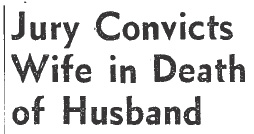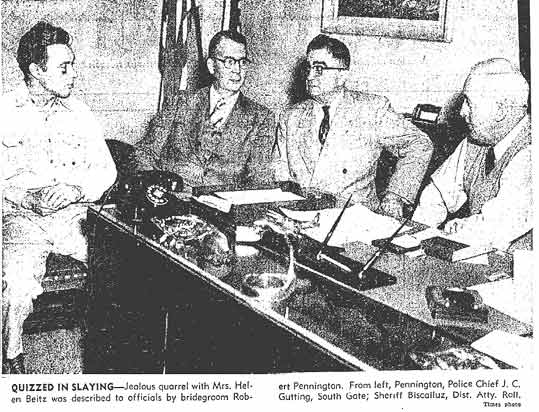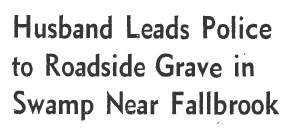The holidays are not a joy for everyone. Family gatherings and booze can be a volatile, and sometimes deadly, mix. Petty grievances which have festered for months occasionally erupt into violence; but whether it is a long-standing feud, a dispute over who is in charge of the remote, or an argument over who can claim the last slice of pumpkin pie, holiday homicides are often the result of too many cocktails and too much togetherness.
In the case of the Thorpes the catalyst for violence wasn’t a piece of pie or a drumstick, it was the visit by a former spouse that caused a fatal argument.
 On November 27, 1952, Thanksgiving evening, Seal Beach cops received a telephone call from forty-one year old Frances Conant Thorpe. She said that she and her husband, fifty-two year old Garden Grove businessman Herman T. Thorpe, had spent the day drinking and arguing and she had shot him as they wrestled for possession of a revolver. According to Frances the argument started after her ex-husband, Al McNutt, had dropped by to extend Thanksgiving greetings to the newlywed couple — the Thorpes had been married just eight months.
On November 27, 1952, Thanksgiving evening, Seal Beach cops received a telephone call from forty-one year old Frances Conant Thorpe. She said that she and her husband, fifty-two year old Garden Grove businessman Herman T. Thorpe, had spent the day drinking and arguing and she had shot him as they wrestled for possession of a revolver. According to Frances the argument started after her ex-husband, Al McNutt, had dropped by to extend Thanksgiving greetings to the newlywed couple — the Thorpes had been married just eight months.
When questioned by investigators Frances offered serveral different versions of the shooting. She told Officer William Dowdy of the Seal Beach Police Department that Herman had committed suicide, she told Deputy Coroner Walter Fox that she shot Herman twice during a scuffle. Finally she told District Attorney Investigator M.D. Williams that Herman had tried to shoot her and she fell, striking her head on a box, and when she revived several hours later Herman was dead on the bedroom floor.
 Herman’s autopsy revealed nothing to suggest that the bullet wounds to his chest and left forearm were self-inflicted. Investigators determined that the position of the weapon found under Herman’s body and the trajectory of the fatal round made it virtually impossible for his death to have been a suicide.There wasn’t a speck of gunshot residue on the dead man’s hands, nor were there any powder burns on his chest or arm. However there were traces of gun powder on Frances’ bathrobe and on her left hand.
Herman’s autopsy revealed nothing to suggest that the bullet wounds to his chest and left forearm were self-inflicted. Investigators determined that the position of the weapon found under Herman’s body and the trajectory of the fatal round made it virtually impossible for his death to have been a suicide.There wasn’t a speck of gunshot residue on the dead man’s hands, nor were there any powder burns on his chest or arm. However there were traces of gun powder on Frances’ bathrobe and on her left hand.
Frances was held to answer for the slaying.
 The jury deliberated for six hours and twenty-eight minutes before finding Frances Thorpe guilty of manslaughter.
The jury deliberated for six hours and twenty-eight minutes before finding Frances Thorpe guilty of manslaughter.
The Los Angeles Times did not report on Frances’ sentencing hearing.
NOTE: On this Thanksgiving I ask you to remember, you only have to cope with that particularly annoying relative once a year so leave the gun at home. Best wishes for a safe holiday!




![Pennington at grave of Helen Beitz. [Photo courtesy of USC Digital Collection]](https://derangedlacrimes.com/wp-content/uploads/2013/09/pennington-at-grave.jpg)
![Barbara and Robert in court. [Photo courtesy of USC Digital Collection]](https://derangedlacrimes.com/wp-content/uploads/2013/09/penningtons.jpg)